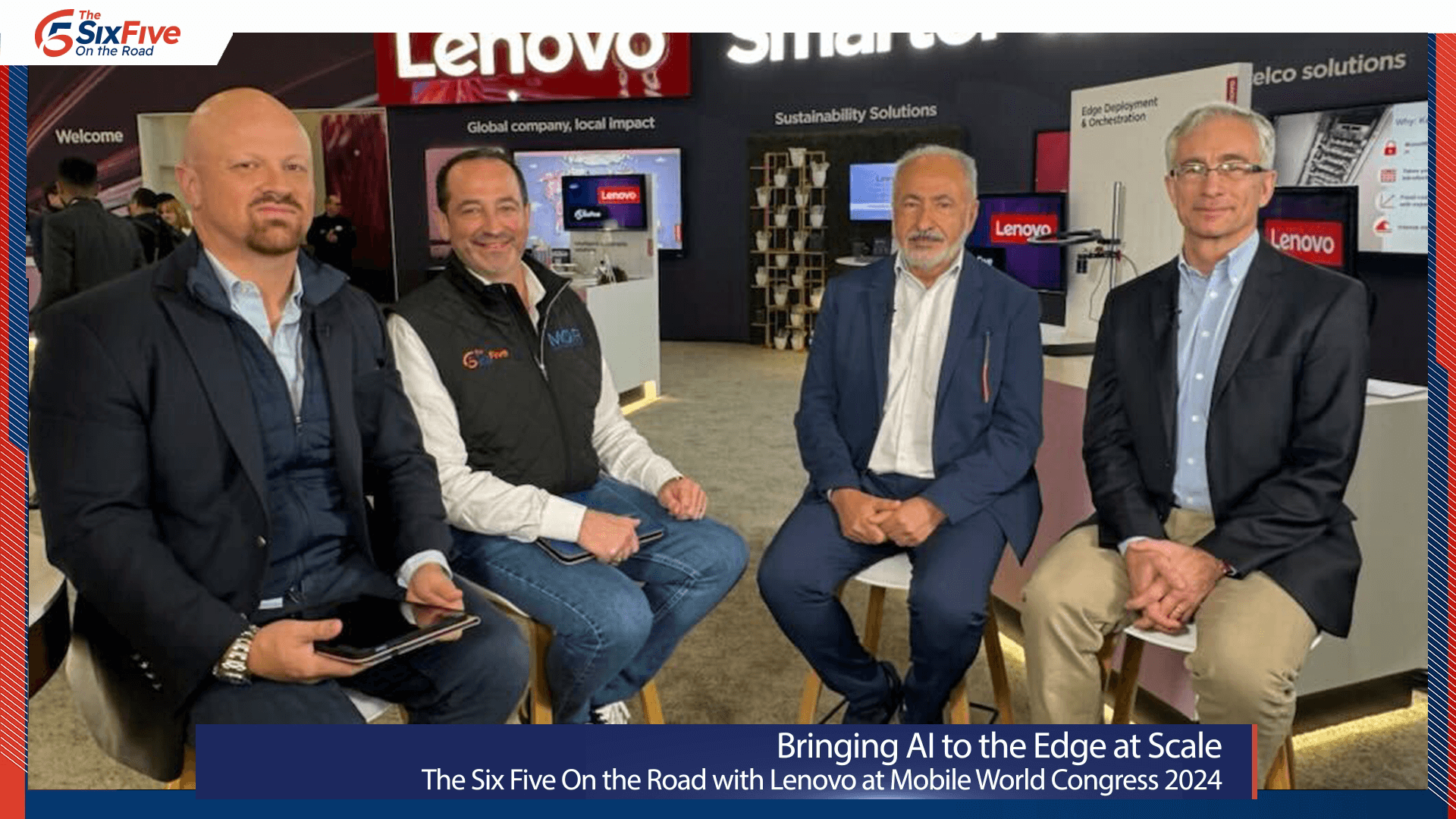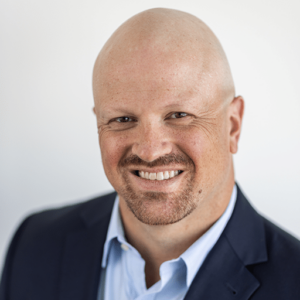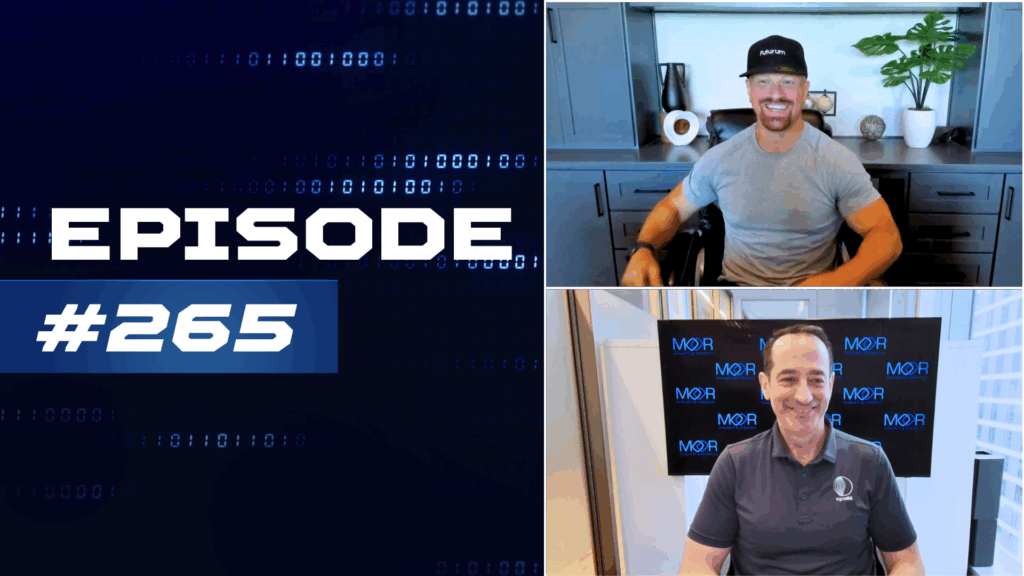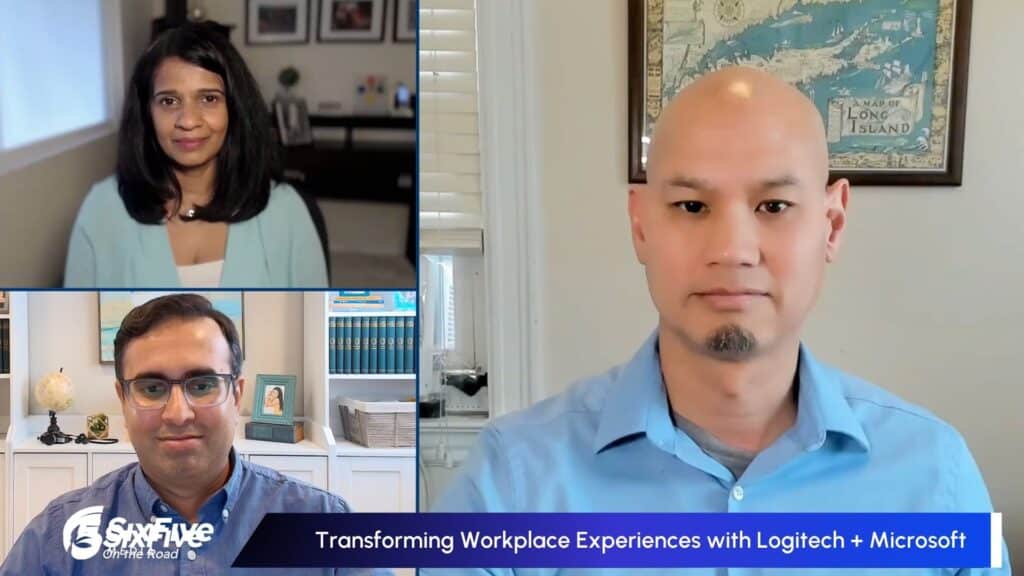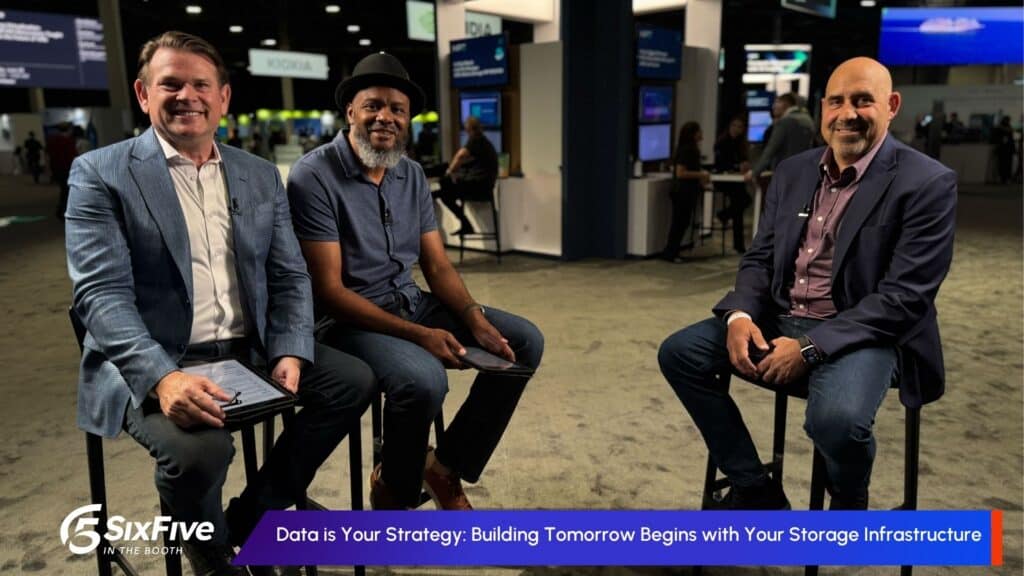On this episode of The Six Five – On the Road, hosts Daniel Newman and Patrick Moorhead welcome Dominique Vanhamme, ED CommSP Segment, Infrastructure Solutions Group at Lenovo and Mehran Hadipour, VP Global Alliances, Rakuten Symphony Inc. (A Rakuten Group Company). Their conversation delves into the future of AI at the edge and how their newly announced solutions are set to revolutionize the adoption and integration of AI in businesses.
Their discussion covers:
- The synergy between Lenovo and Rakuten Symphony, highlighting the collaboration’s objectives and the role of Lenovo’s newly announced solutions in advancing AI integration in businesses
- Understanding the appeal of Lenovo and Rakuten Symphony for companies seeking AI at the edge solutions, and why they stand out in the marketplace
- Insights into customer needs and pain points that inspired the joint solutions by Lenovo and Rakuten, along with the anticipated value these solutions will provide to customers
- Predictions around the evolution of the telecommunications sector and Lenovo’s strategic position within that transformation
Learn more at Lenovo and Rakuten Symphony Inc.
Watch the video below, and be sure to subscribe to our YouTube channel, so you never miss an episode.
Or listen to the audio here:
Disclaimer: The Six Five webcast is for information and entertainment purposes only. Over the course of this webcast, we may talk about companies that are publicly traded, and we may even reference that fact and their equity share price, but please do not take anything that we say as a recommendation about what you should do with your investment dollars. We are not investment advisors, and we ask that you do not treat us as such.
Transcript:
Patrick Moorhead: The Six Five is on the road in Barcelona at MWC 2024. We are here in the Lenovo booth and this show is on fire, Dan. I mean the excitement at the show, all of the people in the hall, we could barely get through Hall 3 yesterday.
Daniel Newman: Yeah, this place has been pretty wall to wall. Just trying to even get in this morning, line wrapped around the building. It’s just really good to see the energy is back. This industry is so critical to the world. Keeping people connected. I don’t think in the end that we think about a lot of these new innovations, whether it’s virtual reality, connected cars, cloud and data center. And then of course the applications that we run every day in our businesses and in our personal lives. There’s so much dependency on the network. It’s everywhere.
Patrick Moorhead: Yeah, Dan. And the criticality of all these pieces coming together all the way from the core network to the edge device and everything in between really makes an impact. And as you sprinkle some AI dust on the whole ecosystem, magic does happen.
Daniel Newman: Yeah, I can’t help but envision a little AI magic pixie dust being dropped over everything. But that’s kind of what’s going on right now. I mean, look, there is a lot of very real AI and over the last multiple decades, AI has been part of the story. But really it’s just risen into the conscious of the world with the advent of large language models. And now we’re seeing here at an event like this that there’s very practical and pragmatic applications for AI, like more sustainability and more efficiency. And then of course some of the really cool stuff that you can do on these devices and it’s getting really exciting.
Patrick Moorhead: It is, and Danny we always say the grand purifier on The Six Five is when we have analysts, system providers, solution providers and a customer on at the same time. And here we have the trifecta, analysts, vendor and a customer. Mehran from Rakuten, great to see you. And Dominique with Lenovo, great to see you. Welcome to The Six Five.
Mehran Hadipour: Thank you.
Dominique Vanhamme: Thank you. Nice to see you guys.
Patrick Moorhead: Absolutely.
Daniel Newman: So Mehran, there’s this growing collaboration that’s taking place here between Rakuten and Lenovo around AI with Rakuten Symphony. Can you just give us a little bit of an overview of the collaboration and the partnership that’s going on and how AI is being sprinkled as we said, how it’s being layered into this relationship?
Mehran Hadipour: Sure, of course. First of all, Lenovo has been a great partner with Rakuten. We know we depend on collaboration and ecosystem to make the customer experience far better. And AI is actually a big part of that as well. You saw an announcement this morning about partnering with OpenAI. We are building a lot of capability around AI to support howcustomers experiences can change. If you think about operator’s expenses around providing service five to seven times OPEX costs as opposed to CapEx. So the main problem to solve is really operations. And AI really a game changer for reducing operational costs for telco operators. And we want that to go entirely down the stack.
So we actually collaborate with Lenovo for the orchestration and automation of platforms at the edge with zero touch to post-deployment, including lifecycle operations, upgrade and updates. All that could be AI driven. The other aspect of AI that is important is the fact that you can actually use AI to understand customers and customers’ behavior and make that experience better. And as such, sell new services, new products and increase your revenue from the operator’s point of view. So I think we see AI roles on both side and Lenovo partnership is a big part of bringing that AI all the way down to the stack. To the point that the infrastructure is managed, services are managed and services are delivered.
Patrick Moorhead: That’s a great explanation.
Dominique Vanhamme: So yeah, we are quite excited. I think we’re certainly contributing also to this back to normal MWC here in Barcelona, making sure there’s all the buzz. So we have over 20 new solution, new use case and certainly top of that with the partnership we have with Rakuten is certainly top of those list here because it’s also very short term but also long term and very strategic alignment. So very excited about that. You mentioned the network. I think way back to the network is the product again and then we probably forgot that in the post COVID years.
And a lot of solutions that we have been talking together that we’ve also been working on together really enable the network from the telecom perspective. And to the AI sprinkle dust, the angel dust perspective. We tend to forget that the telecoms have access to a massive data lake, not only for their own internal use, but also how they can leverage data lakes. In fact, for external and enterprise SMB, different end customers out there and really AI but also edge AI is really that next virtual frontier where you can extend those data lakes and transform that into different services.
So Mehran was referring to more the internal operations of an operator of a telecom operator where we can certainly find optimum positions. We can optimize telco cloud, we can optimize container services, we can optimize radio deployments. We can optimize radio connections, 5G connections and throughput for 5G among other things. But also from an enterprise recent perspective, the telecoms have access to some fantastic gold mine, not even gold dust or fairy dust. But certainly a gold mine of data lakes here that they can absolutely leverage further.
Patrick Moorhead: I’m really struck with the words that you use, Dominique. 15 years ago the conversation was very different and the architecture of carriers and carrier CSPs were quite different. The language that you’re using is more like a modern private cloud in a way. And it just strikes me how far we’ve come as an industry. There’s a lot of competition out there. And I’m curious, what is it that distinguishes Lenovo in this AI space for CSPs? And we’re going to ask you this same hard question after he’s done.
Dominique Vanhamme: So we believe in AI for all. If anything that we’ve learned in the last 12 months from Barcelona last year to today is that I think everybody was surprised by the speed at which large language model was adopted. So shrink-wrapped pre-trained models, we’ll see absolutely a really rapid acceleration and certainly faster adoption. But if you can bring that kind of application, if I can call AI or machine learning an application. If you can run it in fact on a workstation, on a laptop, on a smartphone and use public LMS or public models or even private models or even enterprise class models. All of a sudden a whole new range of applications and benefits can be really being unleashed.
So what we’ve done together is that we believe that by combining Rakuten software with our own portfolio, we can really simplify. So the keyword that we always been talking about is making it as simple as possible because the complexity will be in those models. The complexity will be in that data management, in that data capture, in that data analysis and that data manipulation. So if we can simplify with Rakuten software and our complete solution all across from core data center, from high cluster, high-availability cluster to the far edge. And then really make sure that across telco cloud, hyper-converge solutions, storage clouds, telco cloud storage for instance, and can bring that and enable them that fairy dust. Then all of a sudden we are really in a different space.
Patrick Moorhead: Yeah, it’s interesting, even some of the research we’ve done, when you’re talking about zero-touch provisioning. That didn’t start in the server that started on the client computing on the PC side, it actually made its way over to server technology. So Mehran, what about you? What distinguishes you from your competitors in this space?
Mehran Hadipour: That’s a great question. Think Rakuten has an interesting perspective in this. First of all, the group includes RMI, which is an operator with millions of subscribers and it deployed probably the first end-to-end 5G containerized network in the world. And we are now unleashing AI on that. We are going to create models based on that deployment with the actual live data of a live network and use those models to do a lot of enhanced offerings that are AI driven. Around OSSP, for example. Let’s say you want to do a slice for a specific customer, you can ask the AI engine, “Okay, where can I carve this slice?” And that would save hours and days from getting the delivery of the service fast.
Patrick Moorhead: A slice that’s high bandwidth, low latency.
Mehran Hadipour: That’s right.
Patrick Moorhead: Okay.
Mehran Hadipour: And also based on the customer’s requirements. So the customer is asking you, “I’m going to host this edge application.” And instead of doing six months of planning and trying to figure out where the sites should be placed. You can ask AI, “I’m going to provide this.” And based on the existing data and what we’ve been able to deliver, you can get a reasonably accurate answer most of the time.
So both time to market and also post-deployment, operational benefits are the highly differentiator of any provider. And since Symphony Stack is generally available, we actually announced that we are going to make all O-RAN Software open. So anyone can come and get the O-RAN Software and the documentation announced this morning, yesterday. So the ecosystem partners could build value, add the services on top of the connectivity, and all AI managed. So they’ll also get benefits, the ecosystem partner would get.
Patrick Moorhead: Yeah, it’s fascinating, the openness of the ecosystem. You’re actually providing your technology to also competitive carriers.
Mehran Hadipour: For everyone.
Daniel Newman: It’s great. It’s like the orchestration of a beautiful symphony.
Patrick Moorhead: There we go, Daniel. Dan always comes up with one of them. So there we go.
Daniel Newman: Yes. Well, I hear the music and the music needs to play. It needs an ecosystem, it needs a combination of partners. And what I understand is you’re launching joint solutions and you’re coming to market together. And so I always say collaboration is all about moving faster, exponential value, and of course solving customer problems. Mehran, I’d love to get your take on the problems that you think you’re jointly solving by working together, Lenovo and Rakuten Symphony. And what are some of the solutions that this is yielding? As you’re here at the event, you’re talking to customers, you’re maybe doing some of this together. What are the solutions you’re bringing jointly?
Mehran Hadipour: That’s a great question. I think a lot of people ask the question, so what is the sense of this partnership? Otherwise you have a hardware provider, you’re putting your stack on top of it. The thing that is not so clear sometimes to people is that the deployments are complex, especially for edge-use cases and so on. And there’s a lot of things from the piece of hardware, the drivers to stack to cloud to network functions, to how it’s deployed that has to be tested.
Customers see a lot of value when partners join together. Like SAP and Lenovo to build a focused solution for the edge, for example, that we’ve done, that already, pretested. We have a profile that explains how to deploy it. They’ll get confidence that it’s going to work. They get confidence that it’ll be supportable. It actually adds value to customer’s experience. It is more than just, “Oh, we know each other and we can work on each other.” We like solution-based stack integration and Lenovo has been a great partner to that.
Dominique Vanhamme: I would say two things. Number one, we have to do this at scale. The name of the game for telco is really to do this at profitable scale. So it’s not about deploying 50 sites, it’s not about deploying 10,000 sites. Can we make that efficient? Can we do zero-touch provisioning? But can we deploy all of these endpoints or even regional points as effectively as possible knowing that those equipment needs to stay in those networks for a very long time. So there’s no chance of failure. You cannot tolerate any failure over there.
So the ability to do this at scale is really critical, I think in the discussions and the partnerships and the solutions and the validations that we’ve done together. Number two for me, which is even more important, strategically important is that when we talk AI and when we talk to the various models, there is also a very heavy cost associated with AI. Running AI costs electricity, generates green air gas. With the upper telecom operators having net-zero targets, very tight in net-zero targets, science-based targets for net zero in the 2030, 2040s.
So they have really a big challenge in deploying all of this, but at the same time also reducing the footprints. So all the solutions that we are also working together and building together have also sustainability, having reducing the energy consumption. We really monitor, really has one of the targets as a fringe benefit really. But for me, it’s becoming really central, probably more central in the decision criteria for the end customers.
Patrick Moorhead: So both of your companies, you’ve done a lot of work together in the past to get to where we are today with this announcement. Can you give some idea of what the future holds? And not necessarily, I’m not asking you to pre-announce what the two of you’re doing together, but you’re certainly welcome to do that if you’d like. But this is mostly about a macro, a telecommunications. Where do you see this evolving over the next few years? And maybe Dominique, we’ll start with you.
Dominique Vanhamme: So we believe that by building really large-scale telco cloud, including compute and storage and other functions like hyper-converge, et cetera, really can enable that next generation type of applications. So when we think portable LLM models, portable models, shrink-wrapped models, pre-trained models, the ability to deploy these both from an network operations perspective from the telco inside if you want. But also as a resale model addressing different verticals in the enterprises in different domain, really. By building that cloud together, we simplify really at least the infrastructure layer. And so the complexity still resides, of course, at the data and the model layer. And being able to provide and deliver that I think is really what we work on for the next couple of months, couple of years.
Patrick Moorhead: Yeah. So scale and even more flexibility.
Dominique Vanhamme: Scale, simplicity.
Patrick Moorhead: Getting the connectivity and the compute even closer together.
Daniel Newman: Like a symphony.
Patrick Moorhead: Exactly. There we go.
Dominique Vanhamme: Orchestration, symphony.
Patrick Moorhead: Exactly.
Dominique Vanhamme: Orchestrate and symphony.
Mehran Hadipour: I think I was going to highlight a little bit more what Dominique said. If we are looking at a crossroad for telecom operators, they have issues with capturing customer attention, increasing our pool, getting to beyond connectivity and offering services. They have issues with the infrastructure costs and power, for example. We are going to try to work together to try to solve a variety of these problems. Service delivery, automation, AI-based power management.
All those things require collaboration with the infrastructure provider and doing it at scale, not as once. To be able to, for example, we have AI models even now that we can manage the power consumption when the network is not utilized. So all of these things as a whole would have to work together, get tested together and offered together. I think that’s why we feel our relationship is important and we will continue to work to enhance the value to the end customer by offering these kinds of services on top of the infrastructure,
Patrick Moorhead: And your architecture certainly lends itself to the flexibility to be able to do all those things. And I know that if we’re able to run LLMs on a smartphone and a PC, we can certainly run them on the edge. And even in the larger data centers and probably bigger models than smartphones. But still, it’d be interesting to see if the Symphony can orchestrate even the AI that’s going on the edge with the data center, the cloud model that you’re putting together.
Daniel Newman: Yeah, it’s very exciting to watch how this all plays out. Dominique and Mehran, I want to thank you so much for joining us here on The Six Five, taking a little time out of your very busy MWC schedule. And have a wonderful event and let’s talk soon. I look forward to seeing how this all comes together.
Mehran Hadipour: I hope so. Thank you.
Dominique Vanhamme: Thank you.
Patrick Moorhead: Thank you so much.
Daniel Newman: All right, everybody hit that subscribe button. Join us for all of our coverage here at MWC 2024 here in Barcelona. We’re here in the Lenovo booth in Hall 3. It’s going on here this year at MWC. We’ll see you all back again really soon. But for this show, bye-bye now.
Author Information
Daniel is the CEO of The Futurum Group. Living his life at the intersection of people and technology, Daniel works with the world’s largest technology brands exploring Digital Transformation and how it is influencing the enterprise.
From the leading edge of AI to global technology policy, Daniel makes the connections between business, people and tech that are required for companies to benefit most from their technology investments. Daniel is a top 5 globally ranked industry analyst and his ideas are regularly cited or shared in television appearances by CNBC, Bloomberg, Wall Street Journal and hundreds of other sites around the world.
A 7x Best-Selling Author including his most recent book “Human/Machine.” Daniel is also a Forbes and MarketWatch (Dow Jones) contributor.
An MBA and Former Graduate Adjunct Faculty, Daniel is an Austin Texas transplant after 40 years in Chicago. His speaking takes him around the world each year as he shares his vision of the role technology will play in our future.
